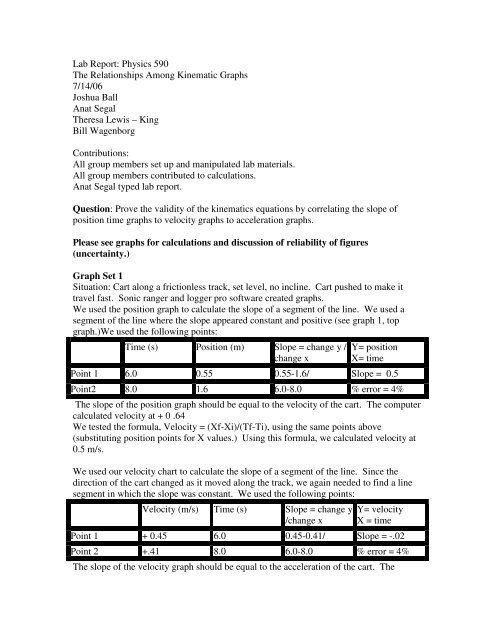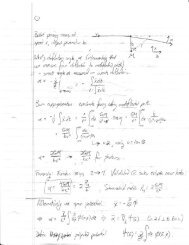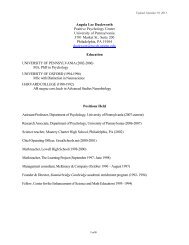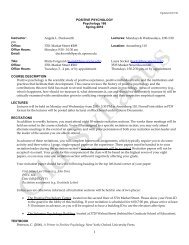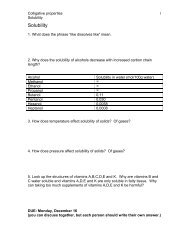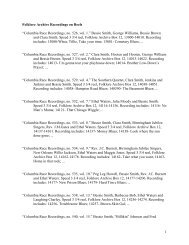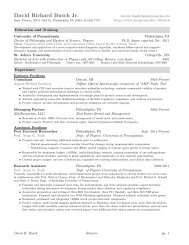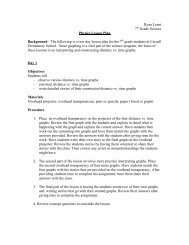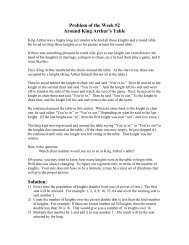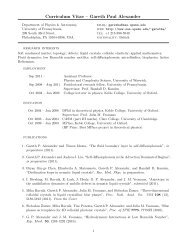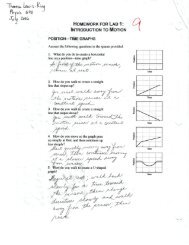Kinematics Lab
Kinematics Lab
Kinematics Lab
You also want an ePaper? Increase the reach of your titles
YUMPU automatically turns print PDFs into web optimized ePapers that Google loves.
<strong>Lab</strong> Report: Physics 590<br />
The Relationships Among Kinematic Graphs<br />
7/14/06<br />
Joshua Ball<br />
Anat Segal<br />
Theresa Lewis – King<br />
Bill Wagenborg<br />
Contributions:<br />
All group members set up and manipulated lab materials.<br />
All group members contributed to calculations.<br />
Anat Segal typed lab report.<br />
Question: Prove the validity of the kinematics equations by correlating the slope of<br />
position time graphs to velocity graphs to acceleration graphs.<br />
Please see graphs for calculations and discussion of reliability of figures<br />
(uncertainty.)<br />
Graph Set 1<br />
Situation: Cart along a frictionless track, set level, no incline. Cart pushed to make it<br />
travel fast. Sonic ranger and logger pro software created graphs.<br />
We used the position graph to calculate the slope of a segment of the line. We used a<br />
segment of the line where the slope appeared constant and positive (see graph 1, top<br />
graph.)We used the following points:<br />
Time (s) Position (m) Slope = change y /<br />
change x<br />
Y= position<br />
X= time<br />
Point 1 6.0 0.55 0.55-1.6/ Slope = 0.5<br />
Point2 8.0 1.6 6.0-8.0 % error = 4%<br />
The slope of the position graph should be equal to the velocity of the cart. The computer<br />
calculated velocity at + 0 .64<br />
We tested the formula, Velocity = (Xf-Xi)/(Tf-Ti), using the same points above<br />
(substituting position points for X values.) Using this formula, we calculated velocity at<br />
0.5 m/s.<br />
We used our velocity chart to calculate the slope of a segment of the line. Since the<br />
direction of the cart changed as it moved along the track, we again needed to find a line<br />
segment in which the slope was constant. We used the following points:<br />
Velocity (m/s) Time (s) Slope = change y<br />
/change x<br />
Y= velocity<br />
X = time<br />
Point 1 + 0.45 6.0 0.45-0.41/ Slope = -.02<br />
Point 2 +.41 8.0 6.0-8.0 % error = 4%<br />
The slope of the velocity graph should be equal to the acceleration of the cart. The
computer calculated acceleration at -0.05 m/s^2.<br />
We tested the formula a=(Vf –Vi)/(Tf-Ti), using the same points above. Using this<br />
formula , we calculated acceleration at -.02 m/s^2.<br />
Graph Set 2<br />
Situation: The situation for this set is the same as above with the exception that the cart<br />
moves more slowly along the track.<br />
Once again we used the position graph to calculate the slope of a segment of the line.<br />
(See graph 2, top graph.) We used the following points:<br />
Position (m) Time (s) Slope = change y<br />
/ change x<br />
Y = position<br />
X = time<br />
Point 1 1.66 4.00 1.66-1.31/ Slope = 0.24<br />
Point 2 1.31 2.55 4.00-2.55 4.0 % error<br />
The slope of the position graph should be equal to the velocity of the cart. The computer<br />
calculated velocity at 0.28 m/s^2.<br />
We tested the formula, Velocity = (Xf-Xi)/(Tf-Ti), using the same points above<br />
(substituting position points for X values.) Using this formula, we calculated velocity at<br />
0.24 m/s.<br />
We used our velocity chart to calculate the slope of a segment of the line. We used the<br />
following points:<br />
Velocity (m/s) Time (s) Slope = change y<br />
/ change x<br />
Y = velocity<br />
X = time<br />
Point 1 0.30 2.0 0.30-0.20/ Slope =-0.05<br />
Point2 0.20 4.0 2.0-4.0 4.0 % error<br />
The slope of the velocity graph should be equal to the acceleration of the cart. The<br />
computer calculated acceleration at -0.03 m/s^2.<br />
We tested the formula a=(Vf –Vi)/(Tf-Ti), using the same points above. Using this<br />
formula , we calculated acceleration at -.05m/s^2<br />
Graph Set 3<br />
Situation: Cart along a frictionless track, set on an incline of approximately 4 cm. Cart<br />
was dropped at the height of the incline. Sonic ranger and logger pro software created<br />
graphs.<br />
We used the position graph to calculate the slope of a segment of the line. We used a<br />
segment of the line where the slope appeared constant and positive (see graph 3, top<br />
graph.)We used the following points:<br />
Position (m) Time (s) Slope = change y<br />
/ change x<br />
Y = position<br />
X = time<br />
Point 1 1.1 1.0 1.65-1.1/ Slope = 0 .55<br />
Point 2 1.65 2.0 2.0-1.0 4.0 % error<br />
The slope of the position time graph should be equal to the velocity of the cart. The
computer calculated velocity at 0.44 m/s<br />
We tested the formula, Velocity = (Xf-Xi)/(Tf-Ti), using the same points above<br />
(substituting position points for X values.) Using this formula, we calculated velocity at<br />
0.55 m/s.<br />
We used our velocity chart to calculate the slope of a segment of the curved line. Because<br />
the line was curved, we drew a line parallel to a segment of the curve and calculated the<br />
slope. We used the following points:<br />
Velocity (m/s) Time (s) Slope = change y<br />
/ change x<br />
Y = velocity<br />
X = time<br />
Point 1 0.44 6.5 0.44-.26 / Slope = 0.2<br />
Point2 .26 5.6 6.5-5.6 4.0 % error<br />
The slope of the velocity graph should be equal to the acceleration of the cart. The<br />
computer calculated acceleration at .25 m/s^2<br />
We tested the formula a=(Vf –Vi)/(Tf-Ti), using the same points above. Using this<br />
formula , we calculated acceleration at 0.2 m/s^2.<br />
Using the bottom graph of graph set three, we approximated the area of a rectangle of<br />
space on the acceleration graph, or the area of the acceleration between acceleration<br />
change, due to change in direction (see graph.) To find the length, we subtracted two<br />
points on the time axis (X). To find the width, we subtracted two points on the<br />
acceleration axis (Y).<br />
Points<br />
Difference<br />
Length 0.357 – 0.103 0.254<br />
Width 6.0 – 3.0 3.0<br />
We multiplied the differences which would approximate the area of the rectangle. We<br />
approximated the area of the rectangle at 0.762.<br />
The distance of the same segment of line in the velocity graph spanned approximately<br />
-0.5 m – 0.4 m, which is approximately -0.9 m in distance.<br />
In conclusion, we used the slope of the position graph and correlated that to the velocity.<br />
We used the slope of the velocity graph to find the acceleration.<br />
We also were able to work in reverse.That is we were able to take two points on the<br />
acceleration graph and drawing a rectangle down from them, we found the area of the<br />
shape.Next we looked at the exact two points on the velocity graph, found the distance<br />
between them and correlated this with the area of the formed rectangle on the<br />
acceleration graph. We could have done the same thing using a rectangle's area on the<br />
velocity graph and correlating it with the distance between the same points on the<br />
distance graph.<br />
This proves in both instances that when given one graph we can get information on the<br />
others.


